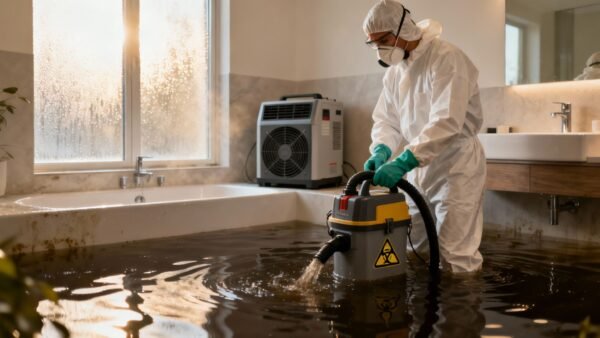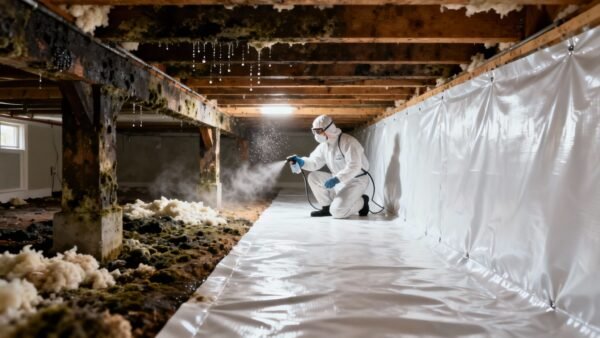When your home is hit by a sewage backup, you're facing more than just a foul-smelling mess—it’s a biohazard emergency that demands immediate, professional attention. This isn't a problem you can solve with a mop and some bleach. Proper sewage damage cleanup is a meticulous process of extraction, sanitization, and structural drying designed to eliminate dangerous pathogens and prevent long-term issues like mold and rot. For Los Angeles homeowners, understanding this process is the first step toward protecting your family and your property.
Dealing with a sewage emergency can feel overwhelming, but you don't have to go through it alone. Our IICRC-certified team is available 24/7 to handle any sewage crisis.
Call (818) 336-1800 for immediate help or to get a free estimate on your cleanup needs.
The Hidden Dangers of a Sewage Backup in Your Home
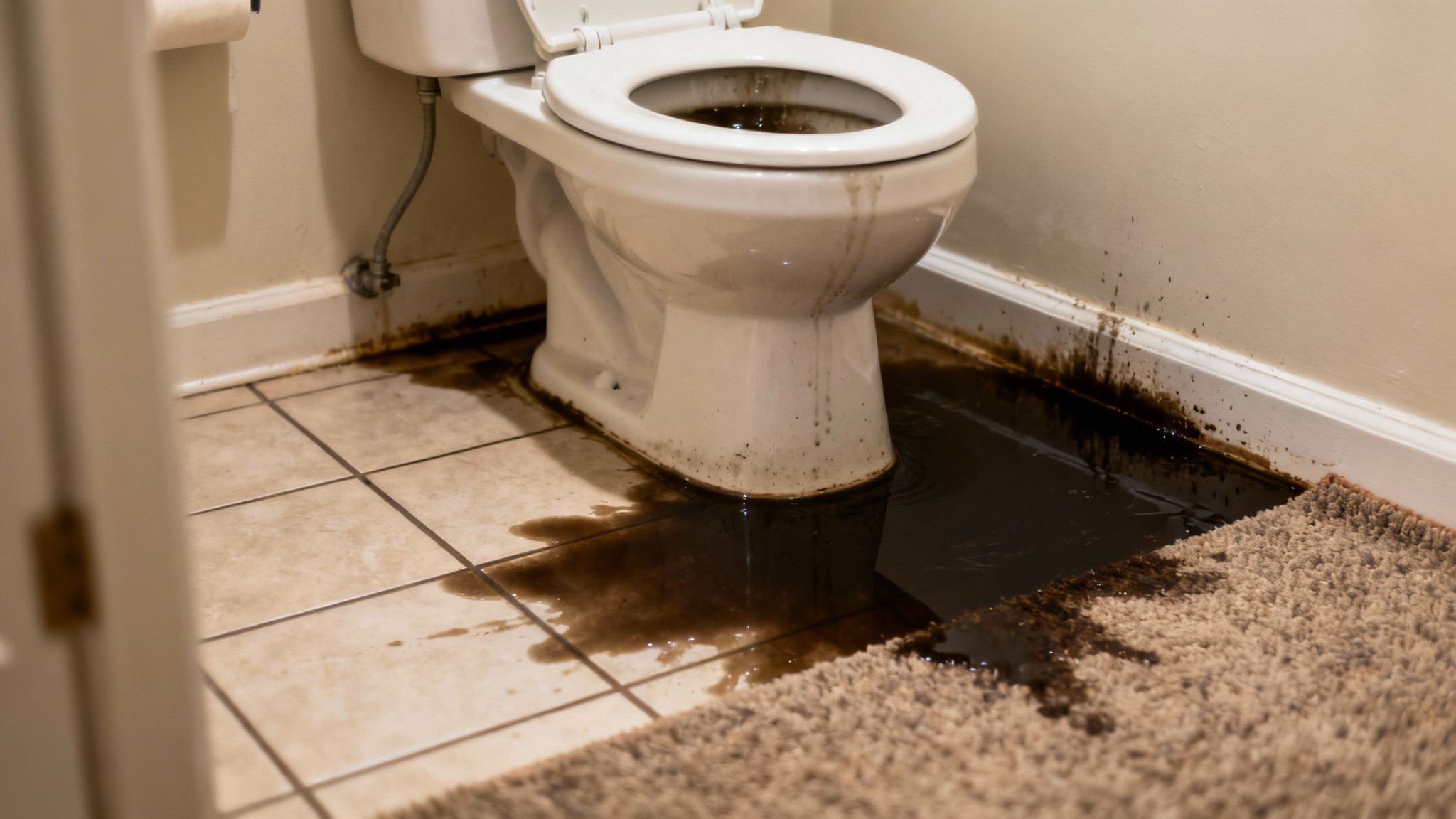
When a toilet overflows or a main sewer line backs up into your home, the immediate visual and olfactory assault is just the beginning. The real threat lurks within the water itself. Water from a sewer line, professionally known as "blackwater," is dangerously contaminated and poses a significant risk to your family’s health and the structural integrity of your home.
This isn't just dirty water; it’s a toxic mixture teeming with:
- Bacteria: Pathogens like E. coli, Salmonella, and Legionella are common, capable of causing severe gastrointestinal illnesses and respiratory infections.
- Viruses: Raw sewage is a breeding ground for viruses such as Hepatitis A and Rotavirus, which can spread easily upon contact.
- Parasites: Microscopic organisms like Giardia and Cryptosporidium can lead to serious and prolonged digestive diseases.
- Chemicals: The water may also carry flushed medications, pesticides, and other hazardous materials that should never be inside your living space.
Why the Damage Goes Deeper Than the Surface
The moment this contaminated blackwater touches porous materials—drywall, carpet, wood floors, insulation—it begins to soak in. Imagine a common Los Angeles scenario: a main line clog from tree roots causes a backup in a downstairs bathroom. Within minutes, that blackwater has wicked up the drywall, seeped under baseboards, and started saturating the subfloor.
The biggest mistake a homeowner can make is underestimating a sewage spill as a surface-level problem. It is almost always a deep-seated biohazard that requires a professional response.
Once absorbed, these building materials become a perfect breeding ground for microorganisms. A simple surface wipe-down is completely ineffective. The contaminants are now embedded deep within the material, meaning it must be professionally removed and disposed of. Furthermore, the lingering moisture creates an ideal environment for secondary problems, which is why understanding the dangers of mold growth is so crucial after any water-related event.
The Larger Impact of Improper Cleanup
The threat of untreated sewage isn’t just a household issue; it’s a global concern. The economic impact of poor wastewater management is staggering. For example, in Kenya, only 11% of wastewater receives proper treatment, exposing millions to contaminated water sources. This illustrates what happens when contaminants are not managed correctly.
That same principle applies directly to your home. An improper cleanup leaves behind hidden health risks that can affect your family for months or even years. This is why professional sewage damage cleanup is so critical—it’s a specialized form of hazardous waste and spill cleanup designed to protect your most important environment.
What to Do Immediately After a Sewage Spill: A Safety Checklist
The moment you discover a sewage backup, panic is a natural reaction. It's an overwhelming and disgusting situation, but your actions in the first few minutes are critical for safety and damage mitigation.
Your immediate steps can prevent the problem from escalating, protecting both your family and your property from more severe consequences. This isn't about starting the cleanup yourself—it's about safely securing the area until professionals can take over. The number one priority is safety. Raw sewage is a toxic biohazard, and the presence of water creates a very real risk of electrical shock.
Step 1: Secure the Area and Protect Your Family
Before you even think about the mess, you must make the environment safe. This involves containing the problem as much as possible without endangering yourself or others.
- Evacuate the Space: Immediately get all children, pets, and vulnerable adults out of the affected area. Airborne contaminants alone can pose a health risk.
- Shut Off Utilities: If you can safely access your home's main circuit breaker without stepping through contaminated water, shut off the power to the affected rooms. You should also turn off the main water supply to your house to prevent more water from feeding the problem.
- Stop Using Water: Do not flush any toilets or run any faucets in the house. This will only add more water to an already overloaded plumbing system and worsen the backup.
- Ventilate (If Possible): If it's safe to enter the general vicinity, open any nearby windows to help disperse odors and some airborne contaminants. Do not use your central HVAC system, as it will spread contaminants throughout your entire home.
Step 2: Document the Damage and Call for Professional Help
Once the area is secure and everyone is safe, your next job is to document the damage and call in the experts. It is absolutely crucial that you do not touch or move any contaminated items yourself.
Every photo you take before the cleanup begins is vital evidence for your insurance claim. Document the extent of the damage, the water line on the walls, and any affected belongings.
After taking photos from a safe distance, your very next call should be to a certified sewage damage cleanup company. This situation is a biohazard that requires specialized equipment, training, and protective gear far beyond what any homeowner possesses. Attempting to clean this yourself exposes you to dangerous bacteria and viruses like E. coli and Hepatitis.
Professional teams are equipped for safe emergency water cleanup and know exactly how to handle contaminated materials according to strict IICRC standards.
Your Role vs. The Professional’s Role in a Sewage Emergency
| Action | What You Should Do Immediately | What Professionals Must Handle |
|---|---|---|
| Evacuation & Safety | Get people and pets out of the area. Shut off power and water if safe. | Establish containment barriers and negative air pressure zones. |
| Water Control | Do not use any plumbing fixtures (toilets, sinks). | Extract raw sewage and contaminated water with powerful pumps. |
| Material Handling | Do not touch or move any affected items. | Safely remove and dispose of contaminated porous materials (carpet, drywall). |
| Cleaning | Nothing. This is not a DIY job. | Clean, disinfect, and sanitize all surfaces with EPA-approved biocides. |
| Documentation | Take photos and videos of the initial damage for insurance. | Provide detailed moisture readings, drying logs, and reports for your claim. |
Your job is to secure the scene and call for help. Leave the hazardous work to the certified technicians who handle these situations every day.
The Professional Sewage Damage Cleanup Process Explained
Once the initial shock subsides and the area is secured, the real work of sewage damage cleanup begins. This is not just mopping up the visible mess; it’s a scientific, multi-step process designed to neutralize biohazards, prevent long-term structural damage, and restore your home to a safe, healthy condition. A certified team follows a detailed plan based on IICRC standards.
The process starts with a thorough assessment. Technicians use specialized equipment like moisture meters and thermal imaging cameras to identify the full extent of the contamination, including moisture that has spread behind walls, under floors, and into the subfloor.
This infographic provides a quick overview of the critical safety actions to take before professionals arrive.
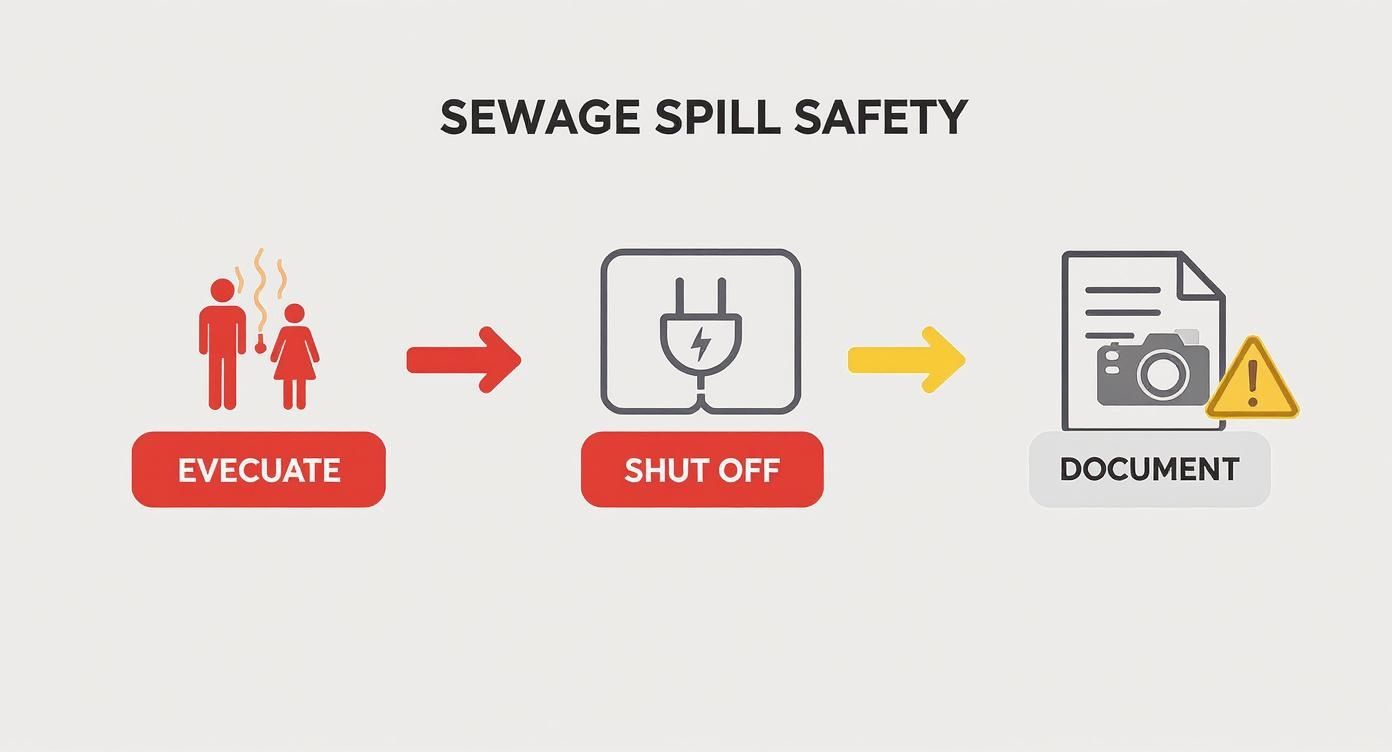
Following these initial steps is crucial for containing the hazard and setting the stage for a safe and effective professional cleanup.
Extraction and Removal of Contaminated Materials
With a clear map of the damage, the team begins the extraction phase. Using powerful, truck-mounted extraction equipment, they remove all standing blackwater and sewage solids. This industrial-grade gear is essential for pulling deeply embedded moisture from materials like carpets and padding.
Next comes the demolition phase. Any porous material that has come into contact with blackwater is considered a total loss and must be removed. This is a non-negotiable safety requirement to protect your health.
Commonly removed items include:
- Drywall and Insulation: Once saturated, they become a perfect breeding ground for bacteria and mold.
- Carpet and Padding: These materials act like sponges, trapping contaminants deep within their fibers where they cannot be safely cleaned.
- Upholstered Furniture: Sofas, chairs, and other fabric-covered items that have absorbed raw sewage cannot be salvaged.
- Baseboards and some flooring: Wood and laminate flooring often warp and trap contaminants underneath.
One of the biggest mistakes we see is homeowners trying to "save" items contaminated by Category 3 blackwater. The risk of harmful pathogens lingering is simply too high. Removal is the only way to guarantee a safe environment for your family.
Deep Cleaning, Sanitizing, and Disinfection
After all contaminated materials are bagged and hauled away, the focus shifts to an intensive cleaning process. Technicians apply EPA-registered, hospital-grade disinfectants and antimicrobial agents to all remaining surfaces, including studs, subfloors, and concrete slabs.
Household bleach is not a suitable substitute. It is not only ineffective on porous surfaces but can also be dangerous, potentially reacting with ammonia in the waste to create toxic gas. Professional biocides are specifically formulated to kill a broad spectrum of bacteria, viruses, and fungi on contact.
Professional crews follow strict protocols to prevent cross-contamination effectively, ensuring the rest of your property remains safe. This sanitization step is a critical part of the overall water damage restoration process, leading directly into the structural drying phase. The job isn’t done until your home is not just clean, but biologically safe.
The Critical Final Step: Professional Structural Drying
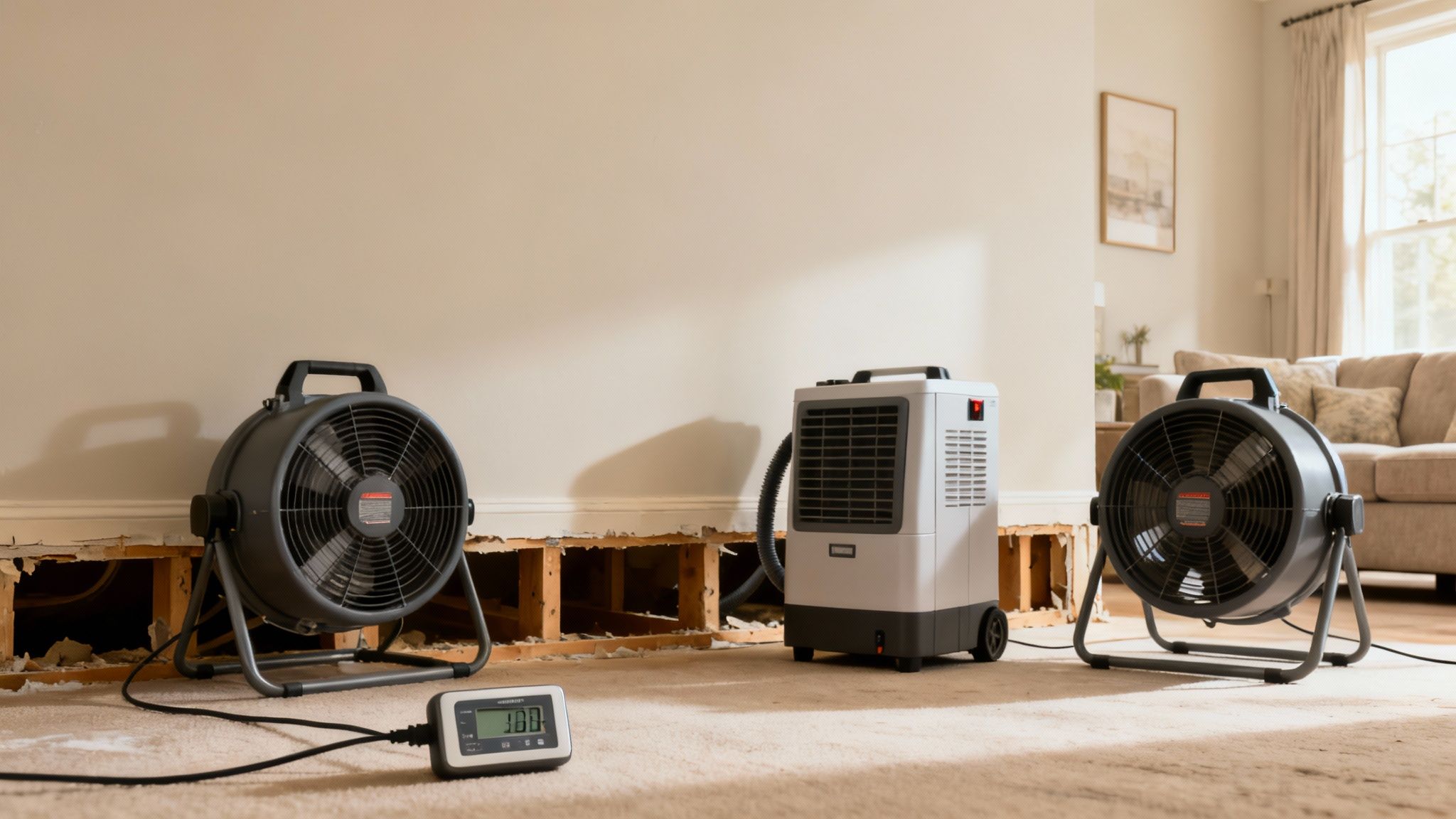
After contaminated materials are removed and surfaces are sanitized, it's easy to assume the worst is over. However, the most deceptive part of sewage damage cleanup is the hidden moisture. Removing standing water is just the first step; the real battle is against the moisture trapped deep inside your home’s structure.
This is where the science of professional structural drying becomes essential. It’s a precise, calculated process that prevents the two greatest long-term threats after a water event: rampant mold growth and structural decay. Without it, lingering dampness in wall cavities, subfloors, and wood framing can silently compromise your home's integrity.
Why Box Fans Aren't Enough
Many homeowners think setting up a few box fans will solve the problem. Unfortunately, this barely scratches the surface. Professional technicians use a carefully planned combination of high-powered equipment to create an optimal drying environment. This isn’t just about moving air; it’s about manipulating temperature and humidity to actively pull moisture out of building materials.
The key tools for this job include:
- Industrial Air Movers: Strategically placed to create powerful, circulating airflow across surfaces, dramatically speeding up evaporation.
- Commercial Dehumidifiers: These powerful machines capture evaporated moisture, pulling gallons of water out of the air each day and preventing it from reabsorbing into other materials.
- Thermal Imaging Cameras: This advanced technology allows us to "see" temperature differences in walls and ceilings, pinpointing hidden pockets of moisture that would otherwise be missed.
Ensuring a Completely Dry Structure
Imagine a leak from a second-floor bathroom in your Sherman Oaks home. Even after you’ve cleaned up the visible water, moisture has likely seeped through the subfloor and is now silently saturating the ceiling joists and drywall in the room below. That hidden dampness is a ticking time bomb for mold.
A structure that feels dry to the touch is not necessarily a dry structure. Professional drying targets specific humidity levels and moisture content within materials, which is the only way to guarantee the job is complete.
This technical expertise is why professional help is so critical. We use moisture meters to take precise readings from wood studs, concrete, and drywall, ensuring every component is returned to its pre-loss dry standard. To learn more about this crucial step, explore our guide on the fundamentals of structural drying for homeowners. This process ensures your property is not just clean, but truly dry and safe for the future.
Navigating Cleanup Costs and Homeowners Insurance
After addressing the immediate health and safety risks of a sewage backup, financial concerns are next. Understanding the potential costs of sewage damage cleanup and how your homeowners insurance will respond is key to managing the financial recovery.
The final cost can vary significantly based on a few key factors, with the primary one being the scope of the contamination. A minor toilet overflow contained within a small, tiled bathroom is entirely different from a main sewer line backup that floods a finished basement with Category 3 blackwater.
Other factors that influence the final cost include:
- Amount of Material Removed: The more drywall, flooring, and insulation that must be cut out and safely disposed of, the higher the cost.
- Equipment Needed: The number of air movers, dehumidifiers, and HEPA air scrubbers required to properly dry and clean the air directly impacts the bottom line.
- Accessibility: A sewage spill in a tight crawlspace is more labor-intensive and requires more specialized procedures than one in an open room, increasing the expense.
Understanding Your Insurance Coverage
When it comes to homeowners insurance, sewage backups exist in a confusing gray area. A standard policy typically covers damage from a clean water pipe bursting inside a wall but almost always has an exclusion for damage from sewer lines, drains, or sump pumps backing up. This fine print catches many homeowners off guard.
The single most important action you can take is to check your policy for a "water backup" or "sewer backup" endorsement. Without this specific add-on, you could be responsible for the entire cleanup bill yourself.
Managing an insurance claim while dealing with the mess is overwhelming, which is a major reason to hire a professional restoration company. We document everything—from initial photos and moisture readings to a detailed, line-by-line scope of work—that your insurance adjuster needs. For more details, our guide on homeowners insurance coverage for water damage provides a comprehensive breakdown.
The Broader Financial Impact of Water Disasters
The financial impact of these events is significant and part of a larger global trend. When factoring in broader economic and ecosystem damage, global disaster costs now exceed $2.3 trillion annually. A single sewage backup is a local problem, but it fits into a larger pattern of water-related losses. As you can learn more about these global disaster cost findings, it becomes clear why professional cleanup is essential.
A professional team doesn't just restore your home; we help you manage the financial recovery by working directly with your insurance provider, ensuring all required paperwork is filed correctly to give you the best chance at a covered claim.
FAQs About Sewage Damage Cleanup
When faced with a sewage backup, it’s normal to have a flood of questions. This is a stressful and confusing situation. To provide some clarity, here are answers to the questions we hear most often from Los Angeles homeowners.
Q: How long does the sewage cleanup process take?
A: The timeline depends entirely on the extent of the damage. A minor overflow contained in a small, tiled bathroom can often be extracted, sanitized, and dried in 2 to 4 days. However, a major backup, like a main line failure flooding a basement, will take much longer. In such cases, removing significant amounts of material and completing the structural drying can easily take a week or more before reconstruction can begin.
Q: Is it safe to clean a small sewage spill myself?
A: No, it is never safe for a homeowner to clean up any amount of sewage. This is "blackwater" (Category 3), which is dangerously contaminated with pathogens. Even a small puddle contains a toxic mix of viruses, bacteria like E. coli, and parasites. Household cleaners are not strong enough to kill these biohazards, and attempting to clean it without proper personal protective equipment (PPE) poses a serious health risk.
Q: What is the difference between water damage and sewage damage?
A: The key difference is the contamination level. Category 1 Water Damage comes from a clean source, like a burst supply line, and does not pose an immediate health threat. Category 3 Water Damage is "blackwater" from a sewage backup and is considered a biohazard. The cleanup for sewage damage is far more intensive, requiring the mandatory removal of all porous materials it touches, followed by a strict, multi-step sanitization process with EPA-registered biocides.
Q: Will my homeowners insurance cover sewage damage?
A: This is a critical question. Most standard homeowners insurance policies do not automatically cover damage from sewer backups. You typically need a specific add-on or endorsement, often called "water backup" or "sewer backup" coverage. Whether your claim is approved depends on the source of the backup and your policy's fine print. A professional restoration company provides the detailed documentation your insurer needs and can work directly with them to streamline the process.
When you’re dealing with a sewage emergency in Los Angeles, you need a team that’s fast, knowledgeable, and equipped to handle the job safely. Onsite Pro Restoration is IICRC-certified and available 24/7 for any sewage cleanup, no matter the scale. We ensure your property is returned to a safe, clean, and healthy state. Don't risk your health—call the professionals. Visit us at https://onsitepro.org or call our 24/7 emergency line now.


